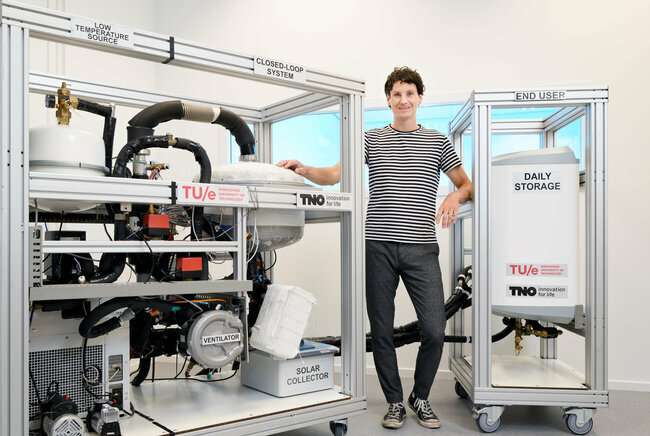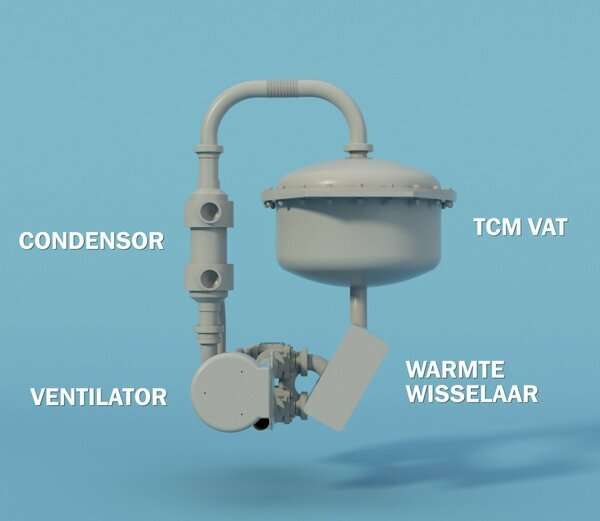Improving materials to increase storage capacity for a home-use salt battery

For several years now, energy storage in salt batteries has been advertised as an environmentally friendly concept that can help accelerate the heat transition. However, product development has only truly hit its stride since recently, says Jelle Houben, Ph.D. candidate at TU/e. He investigated how to improve materials in order to increase the battery’s energy storage capacity, and recently developed a salt battery—in collaboration with spin-off Cellcius—that will be used for real-world tests in residential homes.
If it were up to mechanical engineer Jelle Houben, every household in the near future will have a device the size of a large refrigerator filled with salt tablets. The energy stored in this device can be used to heat our homes, and when the battery is empty, it can be recharged using renewable energy. An environmentally-friendly solution that can help create a natural gas-free built environment.
Ever since his graduation project, Houben has been working on finding ways to make the salt battery applicable. The new closed-loop system he developed with Pim Donkers some time ago, and on which he took out a patent, is currently being further developed by TU/e spin-off Cellcius. As part of his graduation research, Houben set up home temporarily at the department of Applied Physics to improve the chemical reaction in the salt battery. He defended his thesis on Thursday, March 9.
Houben uses a schematic diagram to explain how the salt battery works exactly. “The renewable energy supply comes in peaks and troughs. If you want to have enough energy during periods when there’s isn’t much wind or sunlight, storage is essential. Our salt battery is a form of thermochemical energy storage, where two separate components respond to one another. In this case, salt and water. When the water vapor is carried to the salt, the salt absorbs the water molecules in its crystal lattice. This hydration response creates water that can heat in a boiler. The other way around, heat can be stored via the reversed reaction during which water is released from the salt.”

Dopants for a better battery
Colleagues of Houben found out earlier that in order to make a salt battery more stable and affordable, and to improve its capacity for loss-free energy storage, the best option is to add calcium carbonate. Subsequently, Houben tested several techniques in the lab in order to improve the salt’s performance, which would increase the rate at which the battery is able to charge and discharge. That is why his thesis contains a large chapter in which he describes these various methods. “I find it very interesting to gain knowledge across several fields; I don’t focus exclusively on details. By carrying out various experiments, by building and changing various test setups, and by thinking out of the box now and then, we ended up with a unique system.”
Houben demonstrates that it is possible to accelerate the salt battery’s response speed by adding certain additives, also known as “dopants” in the field. “Cesium carbonate is a very effective addition, but its disadvantage is that it’s a very expensive salt. That is why we tested a variety of organic salts, such as potassium acetate, which is widely available and not as expensive. The results are promising, we’ve managed to improve the battery in a stable fashion at powder level. However, we will use salt tablets in a solid form for the actual system, which is why we will need to do some more follow-up research.”
Bill Gates climate fund
In parallel with the continuing developments on a fundamental level, the first practical studies are now starting to take place. Houben’s employer—he has been working for the aforementioned TU/e spin-off Cellcius for over a year now—recently placed a salt battery in a residential home, in collaboration with the Eindhoven housing corporation Trudo. These pilots are part of the EU project Heat-Insyde. “We are currently setting up a salt battery for a pilot project in France, and another one is heading to Poland. This allows us to test our energy storage system in different climate circumstances.”
Apart from the battery intended for home use, Houben is also working on a transportable battery that can heat an entire neighborhood. This battery will provide some fifty homes with heat and will be transported to local industry every week to be recharged with residual heat. “The test system is operational and is located at the TU/e campus. Now we can start to upscale; we’re still looking for a test location where we can conduct extensive real-world tests. This complete picture, knowledge of salt, the system and the actual application is unique. And that view is shared by many. Bill Gates’ Climate fund recently granted us financial support to conduct further research into our salt battery and to develop it. It’s great that we’ve managed to set this up in Eindhoven and to be able contribute to the energy transition this way.”
More information:
Accelerating Thermochemical Energy Storage by Doping. research.tue.nl/en/publication … gy-storage-by-doping
Citation:
Improving materials to increase storage capacity for a home-use salt battery (2023, March 14)
retrieved 14 March 2023
from https://techxplore.com/news/2023-03-materials-storage-capacity-home-use-salt.html
This document is subject to copyright. Apart from any fair dealing for the purpose of private study or research, no
part may be reproduced without the written permission. The content is provided for information purposes only.
For all the latest Technology News Click Here
For the latest news and updates, follow us on Google News.

